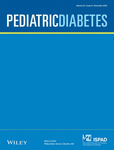Utility of plasma beta-hydroxybutyrate to define resolution of diabetic ketoacidosis
At the time of submission, Dr. Kate Millington is in the process of changing institutional affiliations to Hasbro Children's Hospital and Brown University School of Medicine. Her new Email address is: [email protected].
Funding information: Doris Duke Charitable Foundation, Grant/Award Number: 2019119; National Institute of Diabetes and Digestive and Kidney Diseases, Grant/Award Number: 3K12DK94721-10S1
Abstract
Background
Diabetic ketoacidosis (DKA) is a common, life-threatening complication of type 1 diabetes (T1D) characterized by unregulated ketogenesis caused by relative or absolute insulin deficiency. DKA management requires frequent biochemical monitoring. Plasma ß-hydroxybutyrate (BOHB) has not been included in traditional definitions of DKA resolution.
Objective
The aim of this study was to determine a cut-point level of BOHB to define DKA resolution in patients with T1D treated with intravenous (IV) insulin.
Subjects
We identified patients with T1D receiving IV insulin for DKA treatment at a quaternary children's hospital from January 1, 2017 through December 31, 2020 who had plasma measurements of BOHB after DKA onset and whose DKA resolved by traditional laboratory criteria (venous pH (vpH) ≥ 7.3, serum bicarbonate (HCO3) ≥ 15 mmol/L, and/or anion gap (AG) ≤ 14 mmol/L).
Methods
Associations between plasma BOHB and vpH, HCO3, and AG were evaluated via scatterplots. Receiver operating characteristic (ROC) curves and area under the curve (AUC) were used to evaluate BOHB cut-points to predict DKA resolution.
Results
We analyzed 403 patients with 471 unique encounters. Plasma BOHB showed the most robust relationship with AG. The ROC curve comparing plasma BOHB to the accepted definition of DKA resolution, AG ≤14 mmol/L, had an AUC of 0.92. A BOHB value of <1.5 mmol/L had a sensitivity of 83% and specificity of 87%; this cut-point correctly classified 86% of the observations.
Conclusions
A plasma BOHB value of <1.5 mmol/L can be used to define resolution of DKA.
CONFLICT OF INTEREST
The authors have nothing to disclose.
Open Research
DATA AVAILABILITY STATEMENT
The data that support the findings of this study are available from the corresponding author upon reasonable request.




